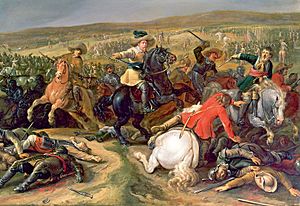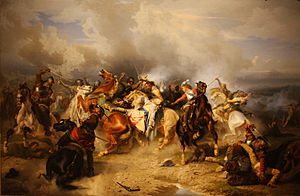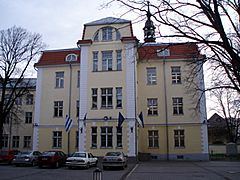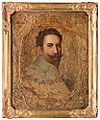Gustavus Adolphus facts for kids
Quick facts for kids Gustavus Adolphus |
|
|---|---|
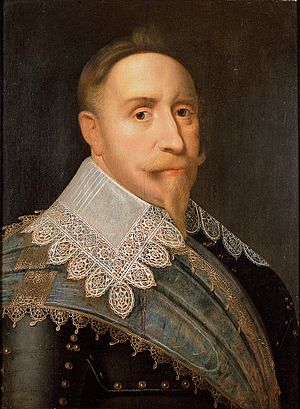
Portrait attributed to Jacob Hoefnagel, 1624
|
|
| King of Sweden | |
| Reign | 30 October 1611 – 6 November 1632 |
| Coronation | 12 October 1617 |
| Predecessor | Charles IX |
| Successor | Christina |
| Born | 9 December 1594 Castle Tre Kronor, Sweden |
| Died | 6 November 1632 (aged 37) Battle of Lützen near Lützen, Electorate of Saxony, Holy Roman Empire |
| Burial | 22 June 1634 Riddarholm Church, Stockholm |
| Spouse | Maria Eleonora of Brandenburg |
| Issue | Christina, Queen of Sweden illegitimate: Gustav of Vasaborg |
| House | Vasa |
| Father | Charles IX, King of Sweden |
| Mother | Christina of Holstein-Gottorp |
| Religion | Lutheran |
| Signature |  |
Gustavus Adolphus (born 9 December 1594, died 6 November 1632) was the King of Sweden from 1611 to 1632. He is famous for making Sweden a very strong country in Europe. This time is known as the Swedish Age of Greatness. During his rule, Sweden became a major military power in Europe. They played a big role in the Thirty Years' War, which changed the balance of power and religion across Europe.
After his death, in 1634, the Swedish parliament officially gave him the title Gustavus Adolphus the Great. Many people see him as one of the best military leaders in history. He used new ways of fighting, combining different types of soldiers. His biggest victory was the Battle of Breitenfeld in 1631.
Gustavus Adolphus was helped by Axel Oxenstierna, a very important Swedish official. Oxenstierna also ruled Sweden for a while after the king died. Gustavus Adolphus became king at just 16 years old. He took over three wars from his father, Charles IX of Sweden. These included fights with Russia and Denmark-Norway. He also had a family dispute with his cousin, King Sigismund III Vasa of Poland.
During his reign, Sweden grew from a local power around the Baltic Sea to one of Europe's most important nations. Gustavus Adolphus is sometimes called the "father of modern warfare." He taught many other military leaders who later helped expand the Swedish Empire. He also improved how Sweden was run, for example, by starting official records of the population to collect taxes and recruit soldiers more easily. Protestants in Europe remember him as a key defender of their faith during the Thirty Years' War. Many churches and groups are named after him, like the Gustav-Adolf-Werk.
Contents
Early Life and Becoming King
Gustavus Adolphus was born in Stockholm, Sweden, on 9 December 1594. He was the oldest son of Duke Charles and his second wife, Christina of Holstein-Gottorp. At that time, his cousin Sigismund III Vasa was king of both Sweden and Poland. However, Duke Charles, who was Protestant, forced the Catholic Sigismund to give up the Swedish throne in 1599. This was part of the religious conflicts before the Thirty Years' War. Charles then ruled as a temporary leader before becoming King Charles IX in 1604.
When his father died in October 1611, Gustavus was only sixteen. He became king at seventeen on 16 December. He also inherited the ongoing family fights with his Polish cousin, Sigismund III, who still wanted to be king of Sweden.
In 1625, Gustavus Adolphus invaded Livonia, starting a war with Poland. He also helped Protestants in Germany, who welcomed him into their cities. In June 1630, he landed in Germany. This marked Sweden's entry into the Thirty Years' War. Gustavus Adolphus joined the side fighting against the Holy Roman Empire and its Catholic allies. His forces quickly turned the tide of the war.
Gustavus Adolphus married Maria Eleonora of Brandenburg. She was the daughter of John Sigismund, Elector of Brandenburg. He chose the city of Elbing in Prussia as his main base in Germany. He died in the Battle of Lützen in 1632. His death was a big loss for the Protestant side. It led to many areas that had become Protestant being taken back by Catholics. His actions in the Thirty Years' War earned him the nickname "the Lion of the North."
Military Genius and Legacy
Historians often call Gustavus Adolphus a brilliant military leader. He is known for his new ideas in warfare. He combined infantry (foot soldiers), cavalry (soldiers on horseback), and artillery (cannons) in new ways. This earned him the title "Father of Modern Warfare."
Future military leaders like Napoleon I of France and Carl von Clausewitz studied and admired his methods. His improvements in fighting made Sweden the most powerful country around the Baltic Sea for the next hundred years. He is also the only Swedish king to be called "the Great" by the Swedish parliament.
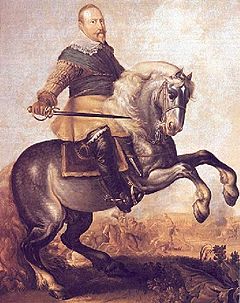
As a general, Gustavus Adolphus used cannons that could move quickly on the battlefield. He also used very aggressive tactics, focusing on attack rather than just defense. He emphasized speed and cavalry charges. One of his key innovations was using "combined arms." This meant his cavalry could attack from behind the safety of his infantry lines, which were supported by cannons. Then, they could retreat back to regroup.
He also used thinner infantry formations, usually 5 or 6 rows deep, instead of the very deep formations common at the time. This made his army more flexible. His cannons were also different. Besides heavy cannons, he introduced light, mobile guns. These could be moved easily and supported his lines of soldiers. This allowed his forces to change positions very quickly, confusing his enemies. He also built the modern Swedish Navy, which helped move troops and supplies to battlefields.
Gustavus Adolphus was known for treating all his soldiers equally. Unlike other armies where cavalry were seen as better than infantry, his units were trained to do different jobs. Cavalry and infantry could help with the cannons. Pikemen (soldiers with long spears) were also taught to shoot. Napoleon thought highly of these ideas and copied them. Some recent historians say that while he was brilliant, he improved existing techniques rather than inventing completely new ones.
Political Ideas and Education
Gustavus Adolphus also had modern ideas for the lands he conquered, like Estonia. In 1631, he made the nobles give more freedom to the peasants. He also strongly supported education. He opened a school in Tallinn in 1631, which is now called Gustav Adolf Grammar School. On 30 June 1632, he signed the order to create Academia Dorpatensis in Estonia, which is now the University of Tartu.
Even though there were tough times for ordinary people, the period of Swedish rule in Estonia is remembered fondly in their stories as the "good old Swedish times." This is often compared to the later rule under the Russian Tsars.
Military Campaigns
When Gustavus Adolphus became king, he inherited three wars from his father. The first was against Denmark-Norway, which had attacked Sweden in 1611. This war, called the Kalmar War, ended in 1613. Sweden did not lose land but had to pay a lot of money to Denmark-Norway. During this war, Gustavus Adolphus allowed his soldiers to plunder towns and villages in Scania. Because of this, his memory in that region is still negative.
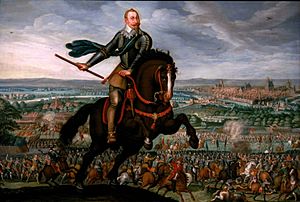
The war against Russia, called the Ingrian War, ended in 1617. The peace treaty meant Russia could no longer access the Baltic Sea. The last inherited war was against Poland, which ended in 1629. This agreement gave the large province of Livonia to Sweden. It also freed up Swedish forces to join the Thirty Years' War in Germany. Swedish forces had already gained a foothold there in 1628.
The region of Brandenburg in Germany was heavily divided by religious conflict. A diplomat named Samuel von Winterfeld convinced Gustavus Adolphus to help the Protestant side in Germany. When Gustavus Adolphus began his advance into northern Germany in 1630, he only had about 4,000 soldiers. However, he quickly strengthened the Protestant position in the north with more troops from Sweden and money from France.
Meanwhile, a Catholic army was destroying Saxony. Gustavus Adolphus met this army and won a major victory at the First Battle of Breitenfeld in September 1631. He then marched across Germany, planning to invade the rest of the Holy Roman Empire. In March 1632, Gustavus Adolphus invaded Bavaria, an ally of the Emperor. He forced his Catholic enemies to retreat at the Battle of Rain. This was the peak of his campaign.
Gustavus Adolphus was said to have gone into battle without wearing heavy armor, saying, "The Lord God is my armor!" However, it's more likely he wore a padded leather jacket instead of metal armor. This was because in 1627, he was shot in the shoulder, and the bullet could not be removed. This injury meant he couldn't wear heavy armor and two fingers on his right hand were paralyzed.
Death and Aftermath
On 6 November 1632, Gustavus Adolphus's army met the Imperial Army at Lützen. The battle that followed was one of the most important of the Thirty Years' War. Gustavus was killed when he got separated from his troops while leading a cavalry charge. Lützen was a Protestant victory, but losing their leader caused the Protestant campaign to lose its way.
Around 1:00 pm, in the thick smoke and fog of the battle, the king got separated from his riders. He was shot multiple times. He rode into enemy lines where he was shot again, stabbed, and fell from his horse. Lying on the ground, he received a final, fatal shot. For some time, no one knew what happened to him. When the smoke cleared, his horse was seen between the two armies, but Gustavus Adolphus was gone. His disappearance stopped the Swedish attack. His body was found an hour or two later and taken from the field.
In February 1633, the Swedish parliament officially gave him the title "Gustavus Adolphus the Great." He is the only Swedish king to receive this honor.

Since other Vasa princes could not become king, and Gustavus Adolphus's younger brother had died, his young daughter Christina became his successor. His mother and other ministers ruled for her. He also had an illegitimate son, Gustav, Count of Vasaborg.
Legacy and Remembrance
Gustavus Adolphus is widely remembered by Protestants in Europe. They see him as the main defender of their cause during the Thirty Years' War. Many churches, foundations, and projects are named after him. He became a symbol of Swedish pride. City squares in major Swedish cities like Stockholm, Gothenburg, and Helsingborg are named after him.
Gustavus Adolphus Day is celebrated in Sweden and Finland every year on 6 November, the day he died at Lützen. A special pastry is often eaten on this day. In Finland, it's also called "the Swedish day." Gustavus Adolphus College, a Lutheran college in Minnesota, USA, is also named after him.

The Gustav-Adolf-Werk (GAW) is a German Protestant organization. It was founded 200 years after the Battle of Lützen. Its goal is to help other churches. The Swedish royal family visited the GAW headquarters in 1994, on Gustavus Adolphus's 400th birthday.
Evaluations of His Reign
The Columbia Encyclopedia says that Gustavus Adolphus was ahead of his time in military organization and strategy. While most countries used hired soldiers, he created a national army. This army was known for its discipline and good behavior. He was very religious and wanted his soldiers to act like a Christian army. He took strong measures against looting and torture, and these rules worked until his death. His success came from this discipline, his use of small, fast units, his better firearms, and his strong personality. He was also interested in improving Sweden, but much of the credit for reforms in industry, money, and government goes to his helper, Oxenstierna.
Some historians, like Peter Englund, believe there wasn't just one reason for Gustavus Adolphus to go to war. It was probably a mix of religious, security, and economic reasons. Another historian, Johannes Burkhardt, points out that Gustavus's own "manifesto of war" didn't mention religion. Instead, it talked about political and economic reasons. He argues that Sweden's actions were not just defensive but also aimed at expanding its power. If he had lived longer, Gustavus might even have tried to become the emperor of the Holy Roman Empire.
Family
| Name | Born | Died | Notes |
|---|---|---|---|
| (Illegitimate) By Margareta Slots | |||
| Gustav |
Stockholm |
Wildeshausen |
Married Countess Anna Sofia Wied-Runkel and had children. |
| By Maria Eleonora of Brandenburg (11 November 1599 – 28 March 1655) | |||
| A daughter | 24 July 1621 Stockholm |
Stillborn, buried in Riddarholmskyrkan. | |
| Christina |
Stockholm |
Stockholm |
Died young; buried in Riddarholmskyrkan. |
| A son | May 1625 Gripsholm Castle |
Stillborn, buried in Riddarholmskyrkan. | |
| Christina |
Stockholm |
Rome |
Became Queen of Sweden (1632 – 1654), never married; buried in Basilica of Saint Peter. |
Images for kids
-
Image of King Gustav Adolph on a wall of Stockholm Palace
-
Cathedral memorial in Borlänge
-
Gustavus Adolphus's sarcophagus at Riddarholm Church
In Music and Stories
The Swedish composer Franz Berwald wrote a choral piece in 1845 about Gustavus Adolphus's victory and death at Lützen. He is also the main character in Max Bruch’s 1898 choral work Gustav Adolf.
Gustavus Adolphus is also an important character in the popular alternate history book series, 1632, written by American historian Eric Flint. The song "The Lion From the North" by the Swedish power metal band Sabaton is about Gustav II.
See also
 In Spanish: Gustavo II Adolfo de Suecia para niños
In Spanish: Gustavo II Adolfo de Suecia para niños
- Gustavus Adolphus Day
- History of Sweden
- Rise of Sweden as a Great Power
- Axel Oxenstierna
- Gustav of Vasaborg
- Gustavus Adolphus College
- Gustav Adolf Grammar School


